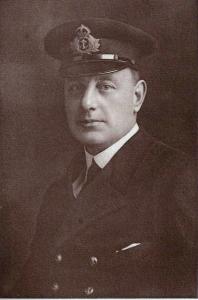
|

|
| Surgeon George SHORLAND RN | |
|
HMS Invincible Royal Navy Date of birth: 18th March 1876 Date of death: 31st May 1916 Killed in action aged 40 Commemorated on the Portsmouth Naval Memorial Panel 11 |

|
| George Shorland was born at Westbury in Wiltshire on the 18th of March 1876 the son of Dr. Edward Peter Shorland, a surgeon, and Caroline Anne Elizabeth (nee Bluett) Shorland of Church Street, Westbury. He was christened at Westbury on the 15th of May 1876. He was educated at the All Saints School, Bloxham near Banbury from 1887 to 1890 and at Lancing College where he was in School House from January 1891 to July 1893. He went on to Guy’s Hospital to study medicine taking MRCS and LRCP Lond in 1901 and graduating as MB ChB in 1906. He worked for a while at the Cambridge Infirmary before moving to London where he worked at the City Hospital in Whitechapel. He was married to Gertrude Harriett (nee Adams) and they had three sons, one of who was Jack. At the time of his death the family was living at Park View Cottage, Berkhamsted in Hertfordshire. He practiced at Mill Hill and worked occasionally as a locum at St Pancras Station where he was medical officer of the Clearing House in Euston Square. He was honorary surgeon to the Railway Benevolent Institution up until he accepted a commission in the Royal Navy. He was appointed as a Surgeon in the Royal Navy on the 3rd of November 1915 and was posted to the battlecruiser HMS "Invincible", part of the 3rd Battle Cruiser Squadron. On the morning of the 30th of May 1916 the Royal Navy received information which led them to believe that the German High Seas Fleet was about to put to sea. By 10.30 am, the British Grand Fleet was at sea, some two and half hours before the Germans set sail, with the Third Battle Cruiser Squadron in the vanguard. By the afternoon HMS "Invincible", the flagship of Admiral Horace Hood, joined Admiral Beatty's larger force as they closed with the German fleet and led the fleet towards what would become known as the Battle of Jutland. At 6.15pm on the 31st of May 1916 she opened fire on the enemy fleet at a range of 10,000 yards disabling the two German light cruisers "Wiesbaden" and "Pillau" (although "Pillau" managed to escape later). "Invincible" then turned her attentions to the battle cruiser "Lutzow" scoring two hits on her but exposed herself to fire from the battle cruiser "Derfflinger" and also "Lutzow" who was returning fire. Hood directed fire on "Derfflinger" scoring a number of hits and causing a lot of damage to her but she continued to return fire. The fifth salvo from "Derfflinger" hit the roof of Q Turret on "Invincible" penetrating the relatively thin armor there and hitting the ship's magazine. There was a huge explosion followed by a column of black smoke and debris which shot several hundred feet into the air. The vessel broke into two pieces and sank with the loss of 61 officers and 965 men. Only six men survived the sinking. He is commemorated on war memorial at Mill Hill, on the memorial at St Mary’s Church, Northchurch, Berkhamsted, on the memorial at All Saints School Bloxham and on the memorial at Guy's Hospital in London. He is remembered on a carved wooden plaque at All Saints Church, Westbury. |
|
| School House |
Back